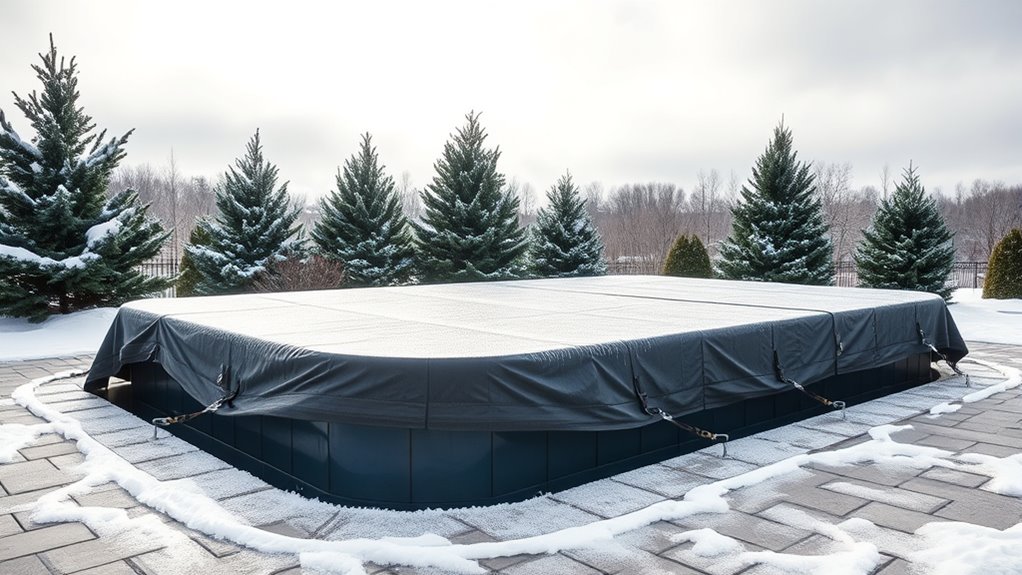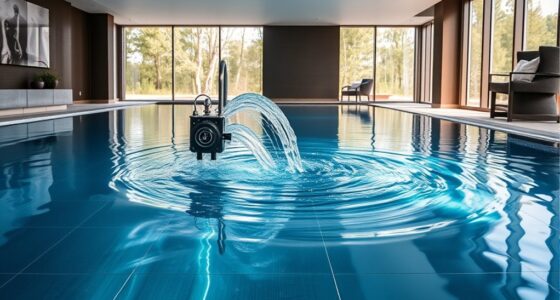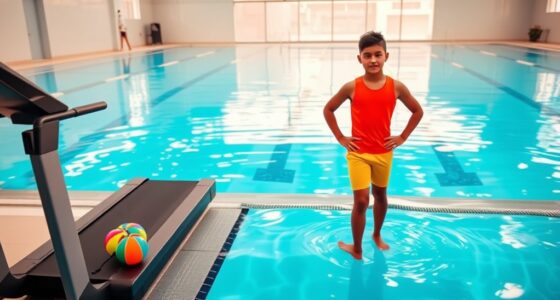To winterize your outdoor endless pool, start by installing a durable, snug-fitting cover to block debris and prevent water evaporation. Balance the water chemistry, lowering sanitizer levels and adding stabilizer to protect against algae and corrosion. Disconnect and store equipment following manufacturer instructions, drain plumbing to avoid freezing damage, and consider using circulation devices or freeze protection systems. Proper preparation now will make reopening easier—continue for detailed steps to guarantee your pool stays protected all winter.
Key Takeaways
- Select and install a high-quality, snug-fitting winter cover to prevent debris entry and reduce maintenance.
- Balance water chemistry, including pH, alkalinity, and sanitizer levels, before covering the pool.
- Drain and disconnect pumps, filters, and plumbing according to manufacturer instructions to prevent freezing damage.
- Maintain water circulation during winter with a small pump or freeze protection system to prevent stagnation and ice buildup.
- Regularly monitor water chemistry and condition of the cover throughout winter to ensure proper protection and readiness for spring reopening.

As winter approaches, it is vital to prepare your outdoor Endless Pool to withstand the cold months and maintain its condition. The first step is investing in a high-quality pool cover. A durable cover acts as a barrier against debris, leaves, and dirt that can accumulate during the off-season. It also helps prevent water evaporation, which conserves your pool’s chemical balance and reduces the need for frequent refills in spring. Make sure the cover fits snugly over your pool, sealing all edges properly to keep out snow, ice, and unwanted critters. This not only protects your investment but also simplifies the winterization process by minimizing the amount of cleaning and maintenance needed when you reopen the pool.
Once the cover is in place, focus on chemical maintenance. Even during the off-season, your pool water needs regular attention to prevent algae growth, bacteria, and other contaminants. Before covering the pool, balance the water’s pH, alkalinity, and sanitizer levels. Lower the chlorine or other sanitizer levels to a maintenance level recommended for winter, which helps keep the water safe while minimizing chemical consumption over the months. Adding a stabilizer, like cyanuric acid, can help protect chlorine from sunlight and prolong its effectiveness. To prevent algae buildup, consider adding a winter algaecide, but follow the manufacturer’s instructions carefully to avoid over-treating.
While the pool is covered, it’s essential to monitor the water chemistry periodically. Use test strips or a reliable testing kit to check the levels every few weeks. Adjust your chemicals as needed, keeping the water balanced to prevent corrosion of your pool’s equipment or damage to the surface. Proper chemical maintenance during the winter also involves circulating the water occasionally, if possible, to prevent stagnation. Many pool owners opt for a freeze protection system or a small, energy-efficient pump to keep the water moving, reducing the risk of ice formation that can crack the pool shell. Additionally, understanding the importance of risk assessment can help you identify and mitigate potential issues before they become costly problems.
In addition, draining or winterizing the pool’s plumbing and equipment is critical. Follow your manufacturer’s instructions to properly disconnect and store pumps, filters, and any accessories. This step prevents freezing damage and prolongs the life of your equipment. To sum up, a well-fitted pool cover coupled with consistent chemical maintenance ensures your outdoor Endless Pool remains in excellent condition throughout the winter, ready for quick reopening when spring arrives. Proper preparation now will save you time and money later, making your winterization process smooth and effective.
Frequently Asked Questions
How Often Should I Check the Chemical Levels During Winter?
You should check the chemical levels at least once a week during winter. Regular chemical testing helps you monitor water balancing, ensuring proper pH, alkalinity, and sanitizer levels. If you notice any discrepancies, adjust the chemicals promptly to prevent algae growth or corrosion. Maintaining consistent water chemistry not only keeps your pool clean but also extends its lifespan, even when it’s not in regular use during the colder months.
Can I Leave the Pool Cover on During Freezing Temperatures?
Imagine the icy wind whispering past your pool as you consider your options. Yes, you can leave the cover on during freezing temperatures, but guarantee it’s in good condition for proper cover maintenance. Use insulation techniques like bubble covers or foam boards underneath to trap heat and prevent ice damage. Regularly check the cover for tears or debris, so your pool stays protected and ready for use when spring arrives.
What’s the Best Way to Remove Residual Water From the System?
To remove residual water from your pool system, use drainage techniques like opening valves and drains to let the water flow out completely. You should also tilt the equipment or use a wet/dry vacuum to suction out any remaining water in pipes or fittings. Make sure to check all hoses, filters, and jets for leftover water, ensuring your system is thoroughly drained to prevent freezing damage during winter.
Are There Specific Safety Precautions for Winter Pool Maintenance?
Protect your pool and yourself by prioritizing safety precautions during winter maintenance. Always secure the pool cover tightly to prevent accidents and ensure safe surroundings. Double-check electrical grounding to avoid shocks or equipment damage. Keep a clear, clutter-free workspace, and wear insulated gloves when handling electrical components. Stay vigilant, follow manufacturer instructions, and never work alone—these steps help you stay safe while winterizing your outdoor endless pool.
How Do I Prevent Pipes From Freezing Inside the Pool System?
To prevent your pool pipes from freezing, you should insulate them with pipe insulation, especially in exposed areas. Additionally, open the drain valves to remove residual water, reducing the risk of freezing and cracking. Running a minimal circulation pump during cold nights can also help keep the water moving. These steps guarantee your pool system stays protected throughout winter, avoiding costly repairs and damage.
Conclusion
Now that you’ve winterized your outdoor endless pool, you’re all set to enjoy the colder months without worry. Remember to drain and cover it properly, just like the Victorian gentry safeguarding their grand estates. With these steps, your pool will be protected from freezing temperatures and ready to revive in spring. Embrace the tranquility of winter, knowing you’ve taken the right precautions—no need to be a damsel in distress when the snow falls.








